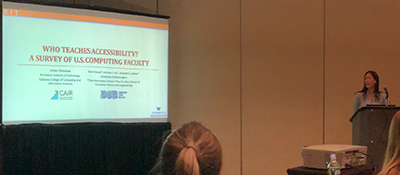
When I first started doing research on the learning of computing, most of my exposure to the topic was through the excellent Association of Computer Machinery (ACM) International Computing Education Research (ICER) conference. As a small, inclusive community of rigorous learning science and education researchers, it was the best way for me to learn about the best work in the field. I had found my people.
From afar, the Special Interest Group on Computer Science Education (SIGCSE) technical symposium was an entirely different beast. My first experience was disorienting: not only was it nearly as large as the ACM Computer-Human Interaction (CHI) conference, my first academic community, but it was and is still dominated by practicing teachers, not researchers. As a researcher, this is both a blessing and a curse. The blessing is that there’s an incredible group of teachers that come ready to learn and change their practices; that’s an unprecedented resource for research dissemination. Nearly everyone I talk to is someone who might adopt my lab’s ideas. However, I rarely get to engage in research conversations about learning to code. This has meant that attending SIGCSE has always felt like more of a dissemination event for me rather than an opportunity to learn about new discoveries and generate new research ideas.
However, this year’s SIGCSE was different than those of the past. Not only was there a dedicated research track for the first time, improving the quality of the research work and attracting more researchers than ever before, but the dialogue between teachers and researchers was more mature and urgent than ever. This was fueled by the national and international efforts at providing access to computing education to everyone, not just those who show up.
The conference was about more than just the ideas in computer science and our goals of spreading it. In fact, the more dominant theme was inclusion, which is at the heart of efforts to broaden participation in computing.
Brenda Wilkerson of AnitaB.org gave the first keynote of the conference. AnitaB envisions a future where “the people who imagine and build technology mirror the people and societies for whom they build it.” Brenda encouraged us to think of efforts to democratize ideas in computing not just as an education reform effort, but a revolution. Her argument was that if we change education to incorporate computer science (CS), and youth embrace CS, we won’t just change what they know and can do, we’ll change the face of who creates and designs technology, which will change technology, which will change the world. Brenda then talked about how to grow this revolution, reviewing her work in Chicago, where CS is now required across K-12.
I spent the rest of the first day of the conference also talking about inclusion. AccessComputing PI Richard Ladner, AccessComputing coordinator Brianna Blaser, and I kicked off the new Inclusion track for the conference on a session about incorporating ideas from accessibility into computer science classes. We shared ideas with our attendees and generated many interesting ideas about integration. For example, some who teach machine learning realized that there were fascinating ways to teach about bias in data by talking about how outliers can emerge from variation in ability. This variation shouldn’t be discarded; rather, machine learning algorithms should be robust to it, which actually means that diversity is a grand challenge for machine learning. Another example for data structures classes showcases how since screen readers require content to be serial or hierarchical, data must be structured into lists, regardless of how else it is structured. Attendees really wanted a website that conveyed all of these resources, which we are working on. Attendees also felt they needed some basic resources to develop their own expertise about accessibility, such as a book covering all of the foundations that they might also use for teaching.
These conversations mirrored the results of a survey that Kristen Shinohara, Saba Kawas, Richard Ladner, and I did to understand who is teaching accessibility in the US. We had a robust audience of 50 attendees with many interesting questions about the cultural changes that might be needed in computer science departments to incorporate even small amounts of accessibility into classes.
On Saturday, I helped lead an AccessComputing session on inclusive learning and teaching. Attendees came from high schools and universities, including some department chairs and even the College Board. Everyone came to learn what inclusion means and how to support it in classrooms and culture. We provided a few basics about universal design and norms, and then walked through some scenarios about students with physical disabilities, learning disabilities, and other issues of neurodiversity.
I had a great time this week in Baltimore. There’s so much energy and passion in this community, across all kinds of institutions and organizations. It’s not the normal research conference, but I think that’s a good thing: If only for a few days a year, leaving the ivory tower and contextualizing my research is invaluable to me and I hope to the world.
A full trip report with my thoughts on big ideas, programming, software engineering, mentorship, boot camps, ethics, and measurement is available on Medium.